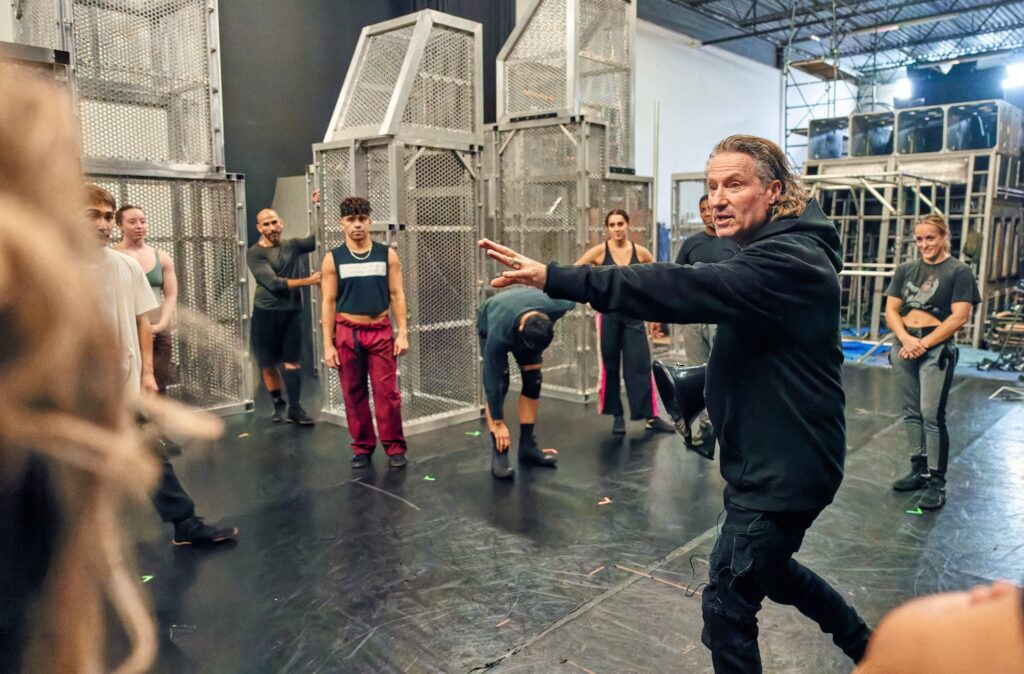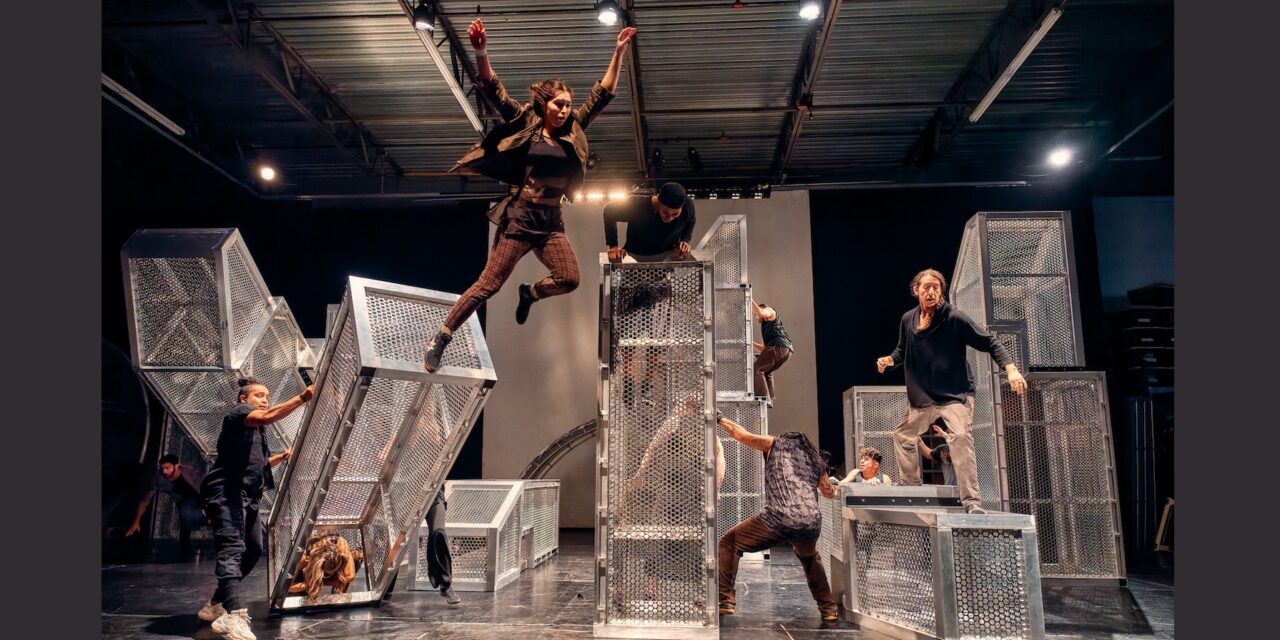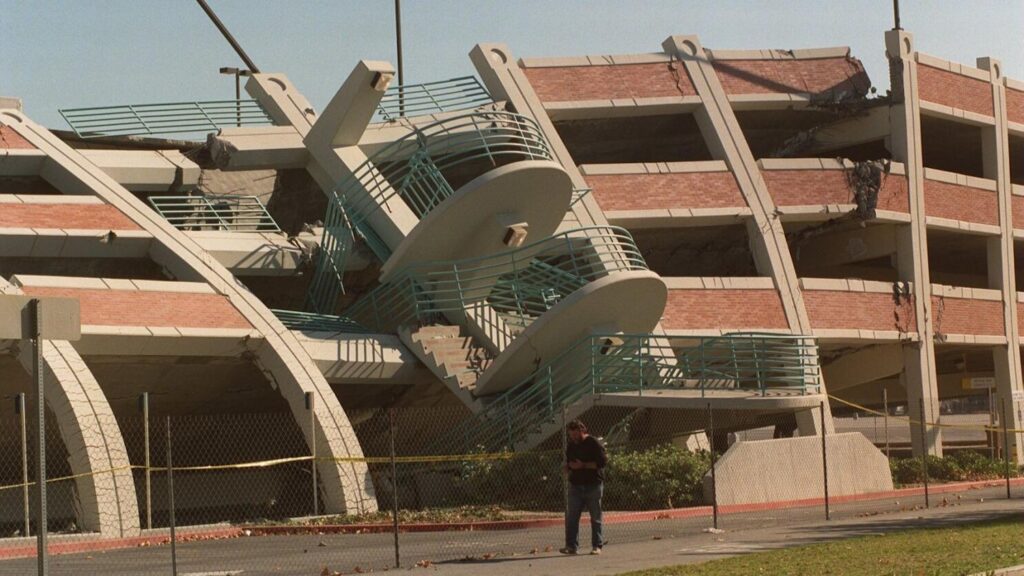Despite 25 years as a power player on the SoCal dance scene, television brought unprecedented, national and international mainstream attention when choreographer Jacques Heim and his Diavolo Architecture in Motion wowed the judges in the 2017 finals of America’s Got Talent. The surge of popular success that followed also drew renewed attention to Heim’s KÀ for Cirque du Soleil, still running in Las Vegas. With the Covid pandemic shutdown in 2020, Heim and Diavolo shifted to the internet and an ongoing Diavolo program involving military veterans.
This week Heim and Diavolo mark a new high in their post-pandemic return with Existencia, an event two years in the making and designed to likely never be seen again.
At 4:31 a.m. on January 17, 1994, Southern California was shaken violently awake by a 6.7 earthquake tremor, what is now known as the Northridge earthquake. At the epicenter, Cal State University Northridge suffered some of the most serious damage and the campus gained the dubious title of having suffered the most destruction of any U.S. university from a natural disaster. The university refused to close, continuing classes in rented trailers and other makeshift facilities despite interruption in services, roads, and public transportation.
On the 30th anniversary of the earthquake and its impact, The Soraya theater on the campus presents Heim and his company in Existencia.
Heim took time from rehearsal to talk by phone about how and why he accepted a commission from Thor Steingraber, executive director at CSU Northridge’s Soroya Center for the Performing Arts to commemorate the 30 year anniversary of an earthquake.
LADC: How did this commission come about?
Heim: Two years ago, when Thor approached me with the idea of a new work marking the 30th anniversary of the earthquake, my reaction was ‘How do you dance about an earthquake?’ But Thor and I go back about 30 years, first when he was at the Music Center and then presenting Diavolo as head of the Soraya. I wanted to think about it before I decided.
LADC: What made you shift to yes?
Heim: I remembered my own experience in the 1994 earthquake and how it significantly shaped the direction of my work for Diavolo.
I had started my company in 1992. When the earthquake struck in 1994, my dance studio was on Parthenia near the Northridge campus, and I was living in an apartment in Northridge. The studio wasn’t too damaged, but the apartment building had serious damage. In the days that followed, I realized I had not known my neighbors before the earthquake, but suddenly we were sharing water, blankets, flashlights, and taking care of each other. In the aftermath of the earthquake, we created a community and it was amazing.
During the two years after starting the company, I had been searching for what was the meaning of Diavolo beyond dancers interacting with objects and structures. My experience after the earthquake became the themes throughout everything I have created—solidarity, unity, commitment, courage, resilience, danger and survival. If you put people in a situation of survival, they come closer together. The 1994 earthquake made me want to capture that community sense without the actual disaster. As I remembered 1994 and how that has become Diavolo’s work ever since, especially the last seven years working with military veterans, my original “no” became “yes.” It was clear to me it would not be just about the destruction, but resiliency, courage, sacrifice, unity, and surviving the danger.
I create obstacles in structures with danger, not for the wow factor but to put my performers in a state of danger, a state of survival so they have to come closer together like a battalion, like a tight community. And the audience viscerally shares the sense of danger and survival as a community coming together in the face of disaster like the 1994 earthquake.
LADC: Were there challenges explaining the earthquake to your dancers, most of whom were not born in 1994?.
Heim: You’re right. That’s why it’s not just about earthquakes or other natural disasters, but also human disasters like war around the globe and personal trauma. Finding ways to survive is part of any disaster.
During rehearsals we talked a lot about disasters: watching the wars on television, watching other earthquakes and floods with the goal of being alive. For many of the dancers the Covid pandemic was a disaster. Many had just graduated and were ready to start or starting their careers when Covid shut everything down in 2020 and 2021. They could not take class, could not perform, could not get other work and no one knew what was happening. They knew people who were sick and who died. There was a huge level of depression and isolation. In a sense, the ground the dancers knew had been shaken by the pandemic, their future uncertain, the surrounding world suddenly unknown and mysterious. The cast also includes military veterans who talked about similar and even more intense events in their deployments and returns. Rehearsals ran eight hours, six days a week for the seven week rehearsal period, and those discussions were an ongoing part of the rehearsals.

Jacques Heim directing Diavolo Architecture dancers in rehearsal for “Existencia” – Photo by George Simian.
LADC: What will we see in Existencia and why did you bring in the Bay Area aerial company Bandaloop?
Heim: This is Diavolo’s first full-evening piece. It runs 65-minutes without intermission. There are 28 performers including extraordinary live music by Antonio Sanchez with wonderful live and looped vocals by Diana Alexa.
I knew the people in Bandaloop and the company is one of the best aerial companies in the U.S. I talked to them about incorporating aerial, but not like in a circus. There’s a section about efforts to rescue someone trapped under a fallen structure, and the aerial is used to reflect her struggle, her fight for her life. Another aerial segment is two men in flight with manipulation of the structures around them creating obstacles as well as places to land and take off. Also, a solo uses aerial to represents all the victims of disaster, natural, war, final flight. Bandaloop was a perfect fit for the aerial rigging and those performance components.
LADC: Will Existencia have other performances or go on tour?
Heim: The stage has a dozen towering metal structures weighing 100 to 500 pounds. We could not fit some of them into our 6,000 foot studio. They were designed specifically for the Soraya and with the weight and size of the structures, Existencia is unlikely to ever be performed again, unless there is a large stage and lots of money to move those towers.
LADC: Was the one-time-only nature of the Existencia intentional?
Heim: I wanted to create an event at that time and at that place just like an earthquake, with the same sense of danger and same post-disaster sense of overcoming differences to build a community that survives.
LADC: Where did the title come from?
Heim: The title Existencia reflects more than just ‘existence’ in English, but draws on Latin, Spanish, and French because this is about the existential, the universal striving to stay alive.
After I decided this could be done, it began as a blank page and I assembled my collaborators for extended consultations about the concept. We came to focus on Rebecca Solnit’s book A Paradise Built in Hell with interviews from different countries with people who survived different types of disasters. Solnit discovered that immediately after a disaster communities have a surprising sense of joy and altruism, they can connect with their community, overcome differences, help each other and help strangers.
LADC: You mentioned your focus in Existencia was refined by Diavolo’s military veterans, how did that happen?
Heim: In the Diavolo program, men and women military veterans are part of a week-long workshop with veterans working with civilian dancers to restore physical, emotional and mental strength. During the workshop, the participants create a piece. Some pieces have gone on to public performance and during the pandemic were the source of several very powerful films.
Working with the Veterans has changed the way I look at the work that we do. Since 1992 I have been interested in architecture as a language and the relationship between the human body and the architectural environment, how it is affecting us emotionally, physically and socially. Working with the military veterans over the last seven or eight years changed the way I look at creating on other human beings and how I want to impact the audience coming into theater to come together. I am not interested in creating another piece for the sake of creating another piece but if it has an important social impact, if it can impact the audience as a community, that I am interested in. That’s what we’re striving for with Existencia.
The dancers in Existencia are: Chris Borrero, Alexa Donnelly, Aaron Franco, Caribay Franke, Co-el Rodriguez, Connor Senning, Daemion Marcuz, Emily Grable, Evan Beek, Jared Bogart, Jarel Lewis, Jarrett Yeary, Kate Dougherty, Kazuma Inohue, Liana Kulchin, Mia Moraru, Oscar Ramos, Paulina Donnelly, Ryan Ruiz, Simon Greenberg, and Steven Jasso.
EXISTENCIA Team: Thana Alexa & Antonio Sanchez, Music Composers and Musicians; Jacques Heim, Diavolo Founder, Artistic Director, and Choreographer; Jim Vincent, Creative Associate Director; France Nguyen Vincent, Writer and Dramaturg; Caribay Franke, Project and Production Manager; Amelia Rudolph, Bandaloop Founder, Aerial Choreographer, and Soloist; Leandro Glory Damasco Jr, Choreographer ; Connor Senning, Rehearsal Director; Ryan Ruiz, Assistant Rehearsal Director; Kate Dougherty, Assistant Rehearsal Director; Simon Greenberg, Video, Sound Effect, and Graphic Designer ; Jean-Yves Tessier, Lighting Designer ; David Touster, Costume Designer ; Adam Davis, City Tower Structure Designer ; Philip Ginolfi, City Tower Structure Fabricator; Steven Jasso, Creative Technical Director ; Mike McClusky, Structure Engineering, Design, and Construction ; and Tina Treffethen, Structure Engineering, Design, and Construction.
Diavolo Architecture in Motion in Existencia at The Soraya, Cal State University Northridge, 18111 Nordhoff St., Northridge; Wed. & Fri. Jan. 17 & 19, 8 pm, $39-$129. To purchase tickets, please visit The Soraya website.
For more information about Diavolo Architecture in Motion, please visit their website.
Written by Ann Haskins for LA Dance Chronicle.
Featured image: Diavolo Architecture in Motion – Existencia – Photo by George Simian














